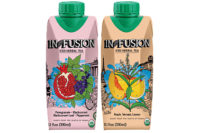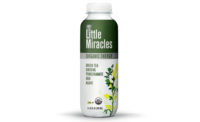In the United States, instant gratification has become commonplace thanks to technologies like smartphones and the Internet, but functional drinks also are making it a staple in the beverage industry. If consumers are tired, they can take an energy drink or shot and feel the effects within a few minutes. Likewise, if they are stressed out or can’t focus, fast-acting options are readily available.
When it comes time to select such functional beverages, consumers’ increased interest in natural or better-for-you products might lead them to purchase a drink formulated with botanicals, suggests Heather Biehl, associate director of the Health Ingredient Technology & Solutions (H.I.T.S.) team at Wild Flavors Inc., Erlanger, Ky.
“Consumers are looking for natural ways to improve their health and [for] natural ingredients in the beverages they consume,” she says. “They may not think caffeine is natural, for example, because it’s very chemical sounding, but tea — something found in nature — just seems more natural.”
What’s your function?
Consumer recognition of many botanicals is boosting their popularity, Biehl notes. This is especially prominent in the energy category where ginseng, guarana, yerba mate and tea are most popularly used, she adds.
Sam Wright IV, chief executive officer of Crowley, La.-based The Wright Group, also notes that natural caffeine substitutes like guarana and ginseng are some of the most popular botanicals used in beverages.
“There is a trend toward all-natural positioning and ‘clean labels,’ which may in part be a reaction against what are perceived as chemical-laden and over-caffeinated energy drinks and other super-fortified beverages,” he says. “It is a matter of segmenting around customer preferences.”
Anne Wedel-Klein, tea and herbal extracts sales for Martin Bauer, Secaucus, N.J., adds that formulating with botanicals is an appropriate solution in line with the clean label trend.
“The ‘unacceptable ingredients’ lists from some retailers are encouraging product developers and brands to take the use of herbal extracts more seriously since herbals offer new flavors to work with and an all-natural ingredient presence,” she says.
Lesser-known botanicals such as kola nut and guayusa also are emerging as natural caffeine alternatives in the energy category, says Mark Blumenthal, founder and executive director of the American Botanical Council (ABC), Austin, Texas, as well as editor-in-chief and publisher of HerbalGram and HerbClip. Kola nut was the original source of caffeine for traditional colas, and guayusa has a higher level of caffeine than guarana, he adds.
Although the botanicals segment has primarily been known for its energy properties, the industry is evolving from energy-specific botanicals to ones with more functional properties, says George Pontiakos, president and chief executive officer of BI Nutraceuticals, Long Beach, Calif. For instance, calming beverages are becoming more popular, he notes. Therefore, ingredients such as kava and chamomile are being used more widely, The Wright Group’s Wright says. The ABC’s Blumenthal adds that lemon balm and passionflower also offer a calming effect.
In addition to energy and calming functions, botanicals such as bacopa and ginkgo biloba can provide increased mental concentration, focus and clarity, he says. “[There is] a potentially bright future for drinks that can increase mental clarity and focus as well as drinks that can have a longer-term cardiovascular benefit,” Blumenthal adds.
Overall, consumers are becoming more interested in consuming foods and beverages that provide value in a convenient format, Martin Bauer’s Wedel-Klein says.
“Today’s consumers live busy lifestyles, juggling home, work and social commitments, which generates substantial stress and weakens their immune systems,” she explains. “This explains their consumption behavior. As a result, people appear to tend to drink more [ready-to-drink] beverages with perceived function over beverages with no healthful values.”
Botanicals can be the solution to some of these issues by offering immunity, digestive health, clarity and calm, Wedel-Klein adds. One such botanical that aids in both immunity and digestive health is aloe. According to Patrick Anderson, Western regional sales manager at Melbourne, Fla.-based Terry Labs, the biggest health benefit associated with aloe is its ability to act as an immune booster.
“It acts as a carrier when taken with vitamins — [it] will get the vitamins to your bloodstream faster and keep vitamins in the bloodstream longer, which improves the efficacy of the vitamins,” he told Beverage Industry in February. Additionally, it aids in repairing and restoring the digestive system, he added.
Likewise, ginger extract has been known to soothe stomach discomfort, Martin Bauer’s Wedel-Klein adds. Pawpaw, elderflower and barks such as cherry and slippery elm also feature medicinal benefits and are gaining resurgence, BI Nutraceuticals’ Pontiakos says.
Taste and see
Aside from their functional properties, botanicals also can impact the taste and color of a beverage, Martin Bauer’s Wedel-Klein says. For instance, beet root can impart a vibrant pink color; hibiscus can produce a strong red color; and safflower can create a bright yellow color, she notes. Additionally, botanicals such as chamomile, ginseng, jasmine and lavender possess a floral aroma, while botanicals like hibiscus, mint and ginger deliver a unique taste experience to a beverage, she explains.
However, when botanicals impart a flavor, it might not always be appropriate for the beverage application. Kava, for example, often poses formulation challenges, The Wright Group’s Wright says. Therefore, the introduction of stevia into this space has been a major development, he says. Microencapsulated ingredients also can help to avoid taste and odor issues, he adds.
Adulteration also can be an issue in the botanicals market, BI Nutraceuticals’ Pontiakos says.
“Many years ago, there wasn’t as much of an understanding as to the level of adulteration that was out there in the beverage market,” he says. “Now … the beverage people are becoming more and more sophisticated as to who they’re buying from and what is the process in place by which they manufacture this component, and I think that’s really a key change within the beverage industry.”
BI Nutraceuticals’ facility is safe quality food (SQF) certified, and many suppliers also seek generally recognized as safe (GRAS) status for their botanicals. GRAS status allows the botanical to be used in conventional beverages as opposed to being limited to dietary supplements, Wild Flavors’ Biehl explains. She also notes a trend of suppliers standardizing their botanical ingredients in order to show that they are using efficacious ingredients. This is especially important because efficacy is the No. 1 benefit of botanicals, BI Nutraceuticals’ Pontiakos says.
“Botanicals are efficacious; they’ve been around for millions of years from when humans were foraging — everything from white willow bark and Echinacea — and up and down the botanical chain, there is a strong cultural legacy usage and a scientific validation thereof of botanicals,” he explains.
Nevertheless, the use of botanicals in beverages still is in the beginning stages for the North American market, Martin Bauer’s Wedel-Klein says.
“We see a lot of activity in the development of drinks and concentrates that are now adding botanicals to existing product concepts as well as designing totally new beverages with the main focus on the botanical,” she says. “Botanicals are getting hot, and in time they will be the new tea in the U.S. beverage scene. … With the non-stop focus on health, wellness and romance stories for new products and higher-end beverages, botanicals [are] the ideal ingredient to be considered by product developers.”
Categorizing ingredients
Most commonly, botanicals are found in energy drinks, shots, stick packets, hot teas and smoothies, Wild Flavors’ Biehl says. However, they could emerge in liquid water enhancers, juices and dairy drinks, she adds.
Martin Bauer’s Wedel-Klein even suggests adding botanicals to alcohol beverages such as beer to “liven up” the brews. “Why not have a beer with fresh lemongrass or fruity hibiscus on a hot summer day?” she asks.
Botanicals also could act as a sugar replacer in beverages that are not viewed as healthy, BI Nutraceuticals’ Pontiakos says. However, he expects the biggest change to be the delivery vehicle of the botanicals.
“Something new is going to get into the delivery vehicle that’s going to make it far more convenient than even a stick pack,” he says. For instance, dispensing caps and other innovations could create new opportunities for consumers to ingest the ingredients, he explains.
In the future, Martin Bauer’s Wedel-Klein predicts that botanicals will expand in terms of the variety of botanical ingredients being used as well as the number of applications in which they are included.
“What we see happening is that the volume of botanicals will be raised with more new product introductions containing botanicals hitting store shelves and the use of traditional and newly discovered botanicals being used in a rainbow of applications,” she says. “To date, botanicals have found a home in the premium beverage sector, but we strongly feel that in the next couple years, botanicals will take the route that tea has taken during the past five years with more mainstream brands highlighting botanicals and developing more interesting options for the consumer.
“The more consumers are exposed to the variety of tastes found in botanicals and the more that consumers are educated on the value of botanicals in a healthy lifestyle, the more botanicals will continue to grow in use in beverages of all types,” she concludes.







